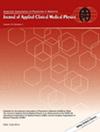Exploring surface-guided systems for intelligent breathing-adapted four-dimensional computed tomography: A comparison to infrared-based reflective marker systems
Abstract
Purpose
This study evaluates the technical feasibility of adapting a surface monitoring system, designed for conventional four-dimensional computed tomography (4DCT), to an intelligent, breathing-adapted 4DCT and examines its potential to expand the currently limited range of supported surrogate systems.
Methods
In an experimental phantom setting, we compared breathing curve quality and its impact on breathing-adapted 4DCT generation between a surface monitoring camera and our clinical infrared (IR) system, using a research-grade IR camera coupled with a radiation detector as an independent reference. Breathing curves from the surface monitoring system and the research-grade camera were corrected for table motion. We assessed the influence of differences in breathing curves on the automatic selection of parameters before scanning, intelligent X-ray triggering during acquisition, and the differences of binning point selection for reconstruction as well as image quality. Additionally, we simulated the impact of latency on image quality and measured the observed latencies between the surrogate systems relative to an X-ray measurement.
Results
During table movement, discrepancies were found in breathing signals from the surface monitoring system compared to the clinical and reference systems. After correcting for table motion, the surface monitoring system's curves aligned consistently with those of the other systems with amplitude (AMP) variations of less than 10% and breathing rate (BR) variations of less than 1%. Corrected curves showed improved performance in their ability to generate breathing-adapted 4DCTs. The clinical IR system showed a 45 ms latency advantage over the surface monitoring system, impacting image quality as simulated.
Conclusions
After correcting surface monitoring breathing curves, satisfactory agreement with the clinical and independent reference systems was achieved. With modifications, the surface monitor solution could serve as a suitable surrogate for breathing-adapted 4DCT. In our experimental setting, the surface monitoring system had a 45 ms delay relative to the clinical system, potentially affecting image quality.


 求助内容:
求助内容: 应助结果提醒方式:
应助结果提醒方式:


